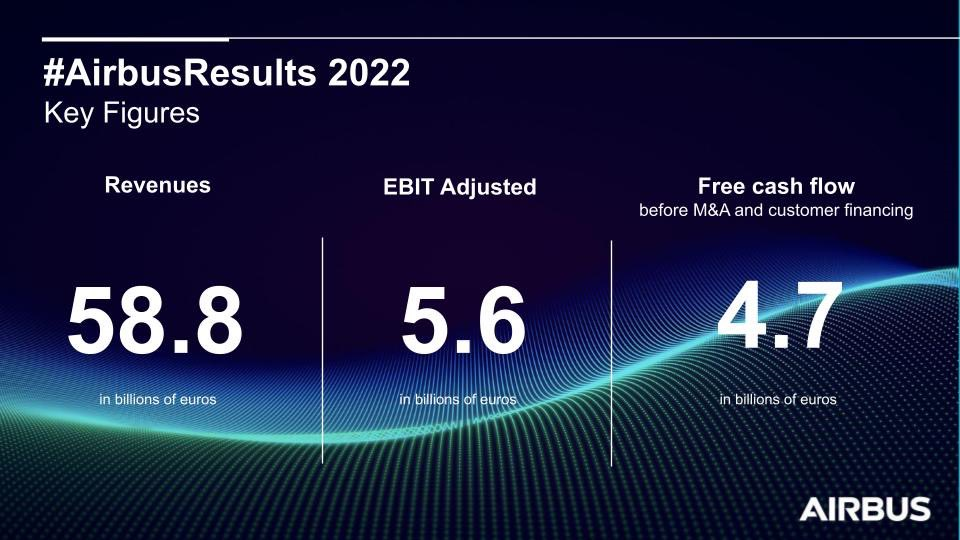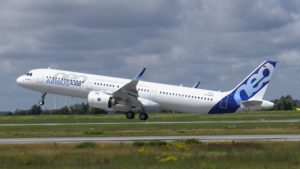Leeham News and Analysis
There's more to real news than a news release.
Airbus posts solid 2022 full-year results despite supply chain problems
By Bjorn Fehrm
February 16, 2022, © Leeham News: Airbus presented its results for 2022 today. The company announced net profits of €4.3bn on revenue of €58.8bn despite several disruptive events during 2022.
Disruptions like the effects of the Russia-Ukraine war and the supply chain ramp after COVID kept the delivery increase for 2022 at half the target of 110 jets, resulting in 661 deliveries instead of the originally guided 720.
Guidance for 2023 keeps the 720 airliner delivery target, an operating profit of €6bn, and a Free Cash Flow of €3bn.
Howmet taking cautious approach projecting OEM deliveries for 2023
Subscription required
By Bryan Corliss
Feb. 15, 2023, © Leeham News – Howmet Aerospace is taking a “cautious and conservative view” that Boeing will build 30 737s a month this year and Airbus will build 53 or 54 A320s and A321s.
 That’s what CEO John Plant told investors Tuesday, as Howmet reported its year-end and fourth-quarter earnings.
That’s what CEO John Plant told investors Tuesday, as Howmet reported its year-end and fourth-quarter earnings.
That’s far more conservative than the 737 build rate that Spirit AeroSystems had projected the week prior, Plant acknowledged. Executives with the Wichita airframer project sending 42 737 fuselages a month to Boeing by the end of this year.
Howmet, which fabricates fasteners and casts pieces for aerostructures and jet engines, reported annual profit of $1.3 billion for last year, up 12% when adjusted for one-time items. For the fourth quarter, its adjusted profit was $336 million, up 13%.
- Howmet ended last year with excess inventory
- Company still projects 17% growth in Commercial
- Howmet hiring, but not everyone is sticking around
Read more
Aerospace supply chain needs capital, which isn’t always easy to find–and it may be expensive
Subscription Required
By Scott Hamilton
Feb. 13, 2023, © Leeham News: The aerospace supply chain is still struggling to recover from the grounding of the Boeing 737 MAX, the suspension of deliveries of the 787, the delays to the Boeing 777X, and the COVID pandemic.
Labor shortages and workforce quality/experience is also a challenge for the supply chain.
Profits remain elusive and capital is available at high interest rates, if at all. CFM, GE, Pratt & Whitney, and Rolls-Royce continue to face technical challenges with their engines. The CFM LEAP and PW Geared TurboFan engines have durability issues and must be taken off wing for maintenance and warranty work at a fraction of the time their predecessor engines were on wing.
It’s a rather bleak picture painted of the state of the aerospace industry during the annual conference of the Pacific Northwest Aerospace Alliance (PNAA) last week in a Seattle suburb.
Summary
- Suppliers need capital; Boeing should return to 30-day payment terms for immediate capital injection.
- Recovery not over, suppliers can make better investments in defense.
- Without a new airplane, there’s no reason for suppliers to invest in commercial.
Orders at risk: Year-End 2022 snapshot
Subscription Required
By Vincent Valery
Introduction
Feb. 6, 2023, © Leeham News: With the publication of the Airbus and Boeing announcing 2022 orders and deliveries last month, and Boeing’s published its 2022 Annual Report (10-K), we undertake our annual analysis of at-risk deals on their books.
Airbus and Boeing have outstanding orders with airlines where there is a material probability some orders won’t translate into deliveries. Most were the result of airlines encountering financial difficulties, but some were related to contractual disputes. Boeing flags such orders as subject to an ASC 606 accounting rule adjustment.
Unlike Boeing, Airbus isn’t subject to an accounting rule like the ASC 606 adjustments at a program level. Therefore, the European OEM does not break down the orders at risk of cancellation by the program. Airbus only discloses the nominal value of its total adjusted order book in its annual report.
LNA analyzed July 2020, November 2020, August 2021, February 2022, and August 2022 Airbus’ and Boeing’s order books to identify orders at risk and come up with an apples-to-apples comparison. We update this analysis with the latest order books from both OEMs. The above links explain our methodology and its differences with Boeing’s ASC 606 adjustments.
Summary
- Lingering order book cleanup for older programs;
- Improving single aisle order book quality;
- Country-level single-aisle market share
- One order materially affects OEM twin-aisle market share.
Pontifications: New Rolls-Royce CEO paints a dire picture; all scenarios on table at Airbus
Jan. 31, 2023, © Leeham News: Rolls-Royce’s new CEO says the engine group is a “burning platform,” failing to give returns.
Tufan Erginbilgic, who joined RR as CEO on Jan. 1, said this is the “last chance” to get its house in order and turn a profit.
The dire outlook has potentially disastrous implications for Airbus. The airframer relies exclusively on Rolls for its engines for the A350 and A330neo. Airbus is monitoring the situation closely. Market sources tell LNA that Airbus is assuring customers and potential customers that Airbus will make sure engines and aftermarket support are available, without detailing how.
An Airbus insider tells LNA that all scenarios are under consideration. Some speculate that Airbus might either provide financial support to Rolls or even, in the extreme, buy the engine company. Others believe either course is unlikely because Airbus has its own production problems to sort out. Its fiduciary duty is to its stockholders. “It’s not their job to inherit a problem that was created decades ago,” one London-based analyst says.
What’s at the root of RR’s current problems? Many of the reasons have been discussed before, but let’s summarize them.
Hexcel reports increased demand for aerospace composites as industry rebounds
By Bryan Corliss
Jan. 27, 2023, © Leeham News: Composites materials supplier Hexcel Corp. reported that its fourth-quarter sales were up 29% over the same period last year, driven by increased demand from all across the aerospace industry.
 “Virtually every platform from narrowbody to widebody to business jets is growing, and the customers continue to ramp as fast as the supply chain allows,” CEO Nick Stanage said.
“Virtually every platform from narrowbody to widebody to business jets is growing, and the customers continue to ramp as fast as the supply chain allows,” CEO Nick Stanage said.
As international air travel recovers, airlines are seeking more widebody jets, which is good for Hexcel, because newer widebodies have higher percentages of composite materials, Hexcel executives told investment analysts. However, new business jet and military aircraft models also incorporate higher percentages of composites.
Stanage and Hexcel CFO Patrick Winterlich noted that their company is not immune from the inflation and labor issues facing most manufacturers, but said they’re coping.
“You can’t give someone five years, three years, of experience in six months or nine months,” Stanage said. “We are working as hard and are focused as hard as we can on training and accelerating it.”
- Hexcel profits beat Wall Street expectations
- Analysts: Can Hexcel match Boeing ramp-up?
- CEO: Commercial aerospace can withstand recession
Read more
The Airbus A220-500, a deep-dive analysis, Part 2
Subscription required
By Bjorn Fehrm
Jan. 23, 2023, © Leeham News: Following Thursday’s article about an up-and-coming Airbus A220-500, we now look at the operational cost for the A220-500 and compare it with the A320neo it should replace.
We put the data we discussed in Thursday’s article in our Aircraft Performance and Cost model, fly the aircraft on a typical single-aisle mission and look at the results.
Summary:
- The A220-500 would be a viable replacement for an A320neo.
- With the changes/improvements we discussed, it beats the A320neo on operational costs. The differences are not of the speculated level, however.
GE, Raytheon report orders surges, but labor and supply chain headwinds
By Bryan Corliss
Jan. 24, 2023, © Leeham News – Aerospace suppliers GE and Raytheon both reported fourth-quarter sales surges, as the commercial aviation industry continued its recovery from the worst of the Covid pandemic.
Both companies also project strong sales growth in 2023, but warned investors that there are lingering supply chain issues and labor shortages that could hold them back.
“While we are broadly beginning to see our supply chain improve, it is not yet at the levels we need,” Raytheon CFO Chris Calio told stock analysts during the company’s fourth-quarter earnings call on Tuesday. “We are assuming a recovery as we move into the back half of the year.”
- GE reports backlog near 10,000 for LEAP
- Raytheon expects double-digit growth for Collins, P&W
- Supply chain improving, but still tangled
- Raytheon talks about Boeing, Airbus rates
Read more
A deep dive into the single-aisle market
Subscription Required
By Vincent Valery
Introduction
Jan. 23, 2023, © Leeham News: Boeing’s share of outstanding single-aisle orders has fallen significantly behind Airbus. If we include the order book for single-aisle aircraft seating 100 or more passengers of Airbus, Boeing, COMAC, Embraer, and UAC, the American OEM’s market share is now 37% (Airbus has 58%, COMAC 3%, Embraer 2%, and UAC 2%).
Richard Aboulafia sees a risk that Boeing’s market share in the single-aisle market will dip below 30% without the entry into service of a new aircraft before 2035. Boeing Commercial Airplanes CEO Stan Deal said that it is viable for the American OEM’s single-aisle market share to stay around 40%.
In the 2022 Boeing outlook, LNA also noted that there are significantly more A320ceo than 737 NG operators. A broader operator base means more opportunities to place new orders with a more diversified group of airlines. In the context of no new single-aisle family entering service in the next 10 years, convincing operators to “flip” to the competition will be the primary way to increase market share.
Exclusively looking at the nominal order books and A320ceo and 737 NG operators does not provide a comprehensive view of Airbus’ and Boeing’s relative positions in the single-aisle market, though.
In their 2022-2041 commercial market outlooks (CMO), Airbus and Boeing indicated that nearly half of all single-aisle deliveries would replace older-generation aircraft. Looking at the existing in-service fleet of older-generation aircraft provides a better picture of replacement order opportunities by the OEM.
LNA investigates in this article the existing order books of the five major OEMs and operator bases to better assess their relative competitive positions and quantify the current replacement order opportunities.
Summary
- A comprehensive single-aisle fleet snapshot;
- Breaking down the order books between replacements and growth;
- Keep track of order choices for older-generation operators;
- Remaining replacement order opportunities;
- A word about single-aisle freighters.





